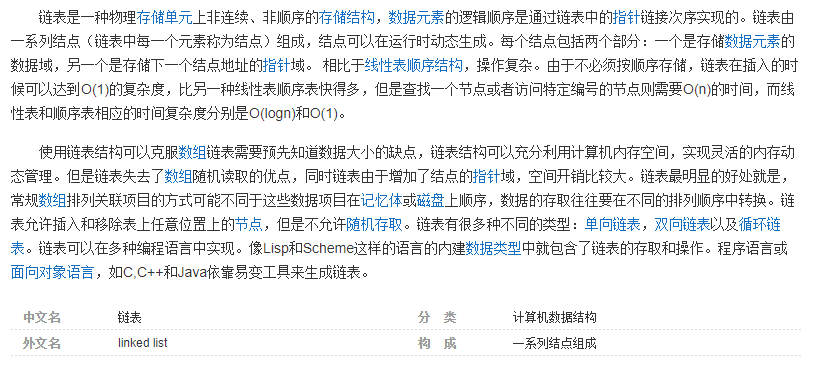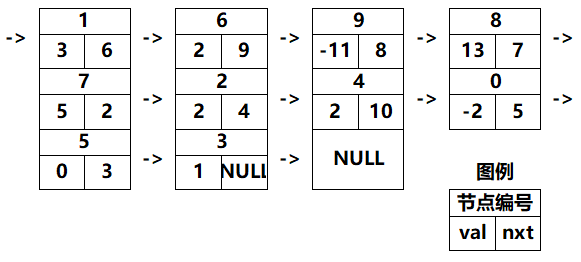邻接表
Summary
动态邻接表相关
Text
链表是什么

摘自 百度百科
链表是一种数据结构, 效果类似于 
链表的作用 (之一)
存图, 在稀疏图上有奇效 (就是邻接表)
栗子: 一张有 100 个节点,1000 条边的图, 用数组存
int mp[100][100];用链表存
struct str
{
int fin, len;
str *nxt;
} mp[1000], *f[100];
int cnt;大小差距极其明显 emmm...
静态链表的写法
略
邻接表的写法
声明
struct str
{
int fin, len;
str *nxt;
} mp[1000], *f[100];
int cnt;插入边
void insert(int orf /*始点*/, int nif /*终点*/, int nel /*边权*/)
{
mp[++cnt].fin = nif;
mp[cnt].len = nel;
mp[cnt].nxt = f[orf];
f[orf] = &mp[cnt];
}遍历一个点的所有出边
for (str *i = f[/*点的编号*/]; i; i = i->nxt)动态链表与邻接表
申明
struct str
{
int fin, len;
str *nxt;
} * f[220];使用 new 动态加边, 实现内存动态分配. 用法
str */*指针名*/ = new /*指向元素类型*/;具体到邻接表里面, 则是
void insert(int orf, int nif, int nel)
{
str *wen = new str();
wen->fin = nif;
wen->len = nel;
wen->nxt = f[orf];
f[orf] = wen;
}使用 delete 删边, 实现内存回收. 用法
delete /*指针名*/;具体到邻接表里面, 则是
inline void remove(int orf, int nif)
{
if (f[orf]->fin == nif)
{
str *i = f[orf];
f[orf] = i->nxt;
delete i;
return;
}
for (str *i = f[orf], *j = i->nxt; j; i = j, j = j->nxt)
{
if (j->fin == nif)
{
i->nxt = j->nxt;
delete j;
}
}
}栗子:
#include <cstdio>
using namespace std;
struct str
{
int fin, len;
str *nxt;
} * f[100];
int n, m, in1, in2, in3, in4;
inline void insert(int orf, int nif, int nel)
{
str *wen = new str();
wen->fin = nif;
wen->len = nel;
wen->nxt = f[orf];
f[orf] = wen;
}
inline void remove(int orf, int nif)
{
if (f[orf]->fin == nif)
{
str *i = f[orf];
f[orf] = i->nxt;
delete i;
return;
}
for (str *i = f[orf], *j = i->nxt; j; i = j, j = j->nxt)
{
if (j->fin == nif)
{
i->nxt = j->nxt;
delete j;
}
}
}
int main()
{
freopen("in.txt", "r", stdin);
freopen("out.txt", "w", stdout);
scanf("%d%d", &n, &m);
while (m--)
{
scanf("%d", &in1);
switch (in1)
{
case 1:
scanf("%d%d%d", &in2, &in3, &in4);
insert(in2, in3, in4);
break;
case 2:
scanf("%d%d", &in2, &in3);
remove(in2, in3);
break;
case 3:
for (int i = 1; i <= n; i++)
{
printf("[%d]", i);
for (str *j = f[i]; j; j = j->nxt)
printf("->[%2d|%2d]", j->fin, j->len);
printf("\n");
}
printf("--------------------\n");
break;
}
}
return 0;
}in.txt
5 11
1 1 3 10
1 3 2 7
1 4 5 9
1 2 4 -1
3
2 2 4
3
1 2 4 1
1 1 5 7
1 5 1 3
3out.txt
[1]->[ 3|10]
[2]->[ 4|-1]
[3]->[ 2| 7]
[4]->[ 5| 9]
[5]
--------------------
[1]->[ 3|10]
[2]
[3]->[ 2| 7]
[4]->[ 5| 9]
[5]
--------------------
[1]->[ 5| 7]->[ 3|10]
[2]->[ 4| 1]
[3]->[ 2| 7]
[4]->[ 5| 9]
[5]->[ 1| 3]
--------------------

Reference
- https://www.cnblogs.com/wanqieddy/p/4372033.html
- https://blog.csdn.net/nyist_zxp/article/details/80810742
- https://blog.csdn.net/qq544529563/article/details/14714387
- https://blog.csdn.net/u010234441/article/details/83310503
- https://blog.csdn.net/qq_35750858/article/details/53184137
- https://blog.csdn.net/sinat_38816924/article/details/78482793

